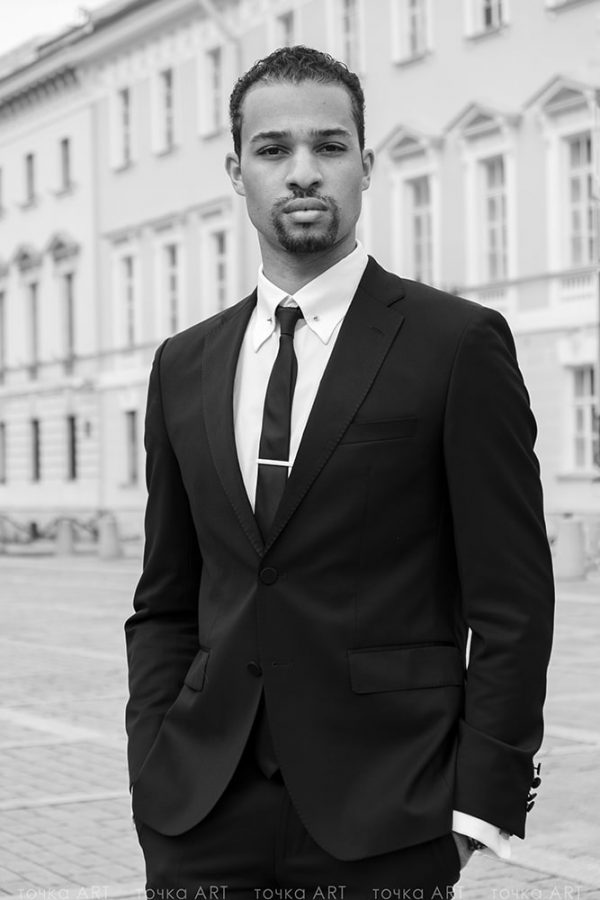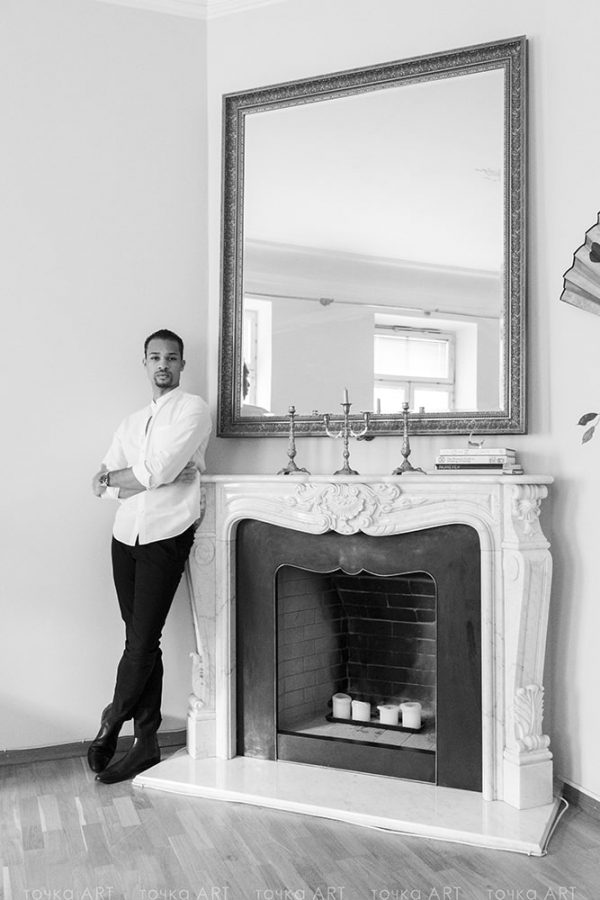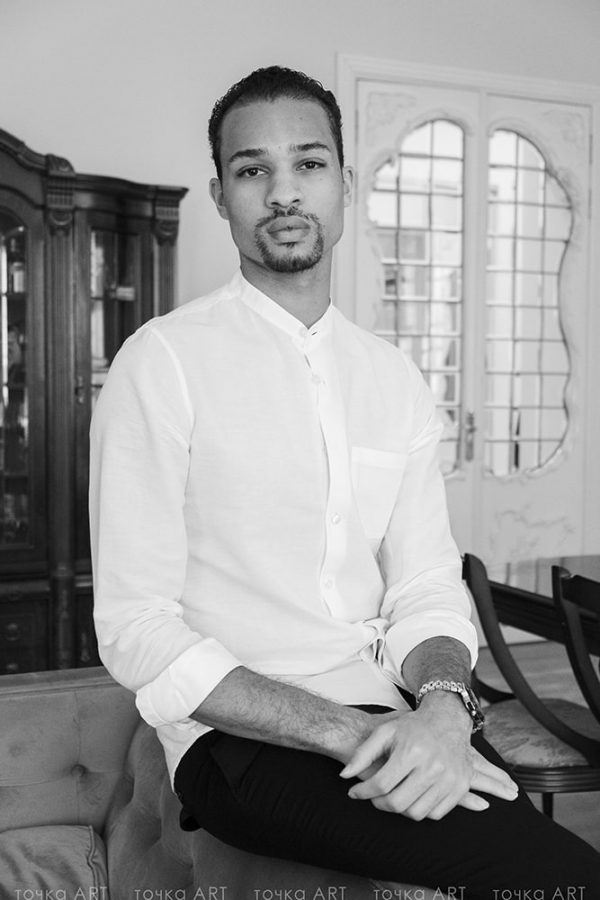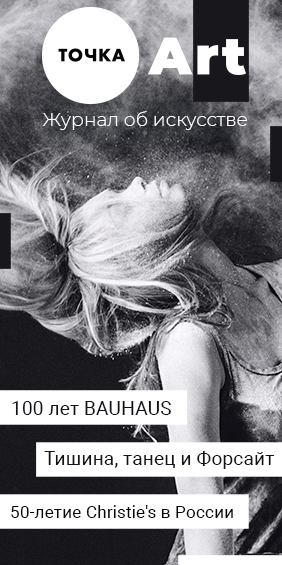Adrian Mitchell: «There can be no equal opportunities in ballet»
Adrian Blake Mitchell, First Artist of the Mikhailovsky Theatre. A native of Texas, a graduate of Allison Ballet and the Vaganova Academy of Russian Ballet, Mitchell has been performing on the stage of the renowned St. Petersburg theater since 2015, participating in all significant productions. ART Point Magazine’s reporter Katia Kuzmina had the great pleasure to talk with Adrian Mitchell about cultural diversity, «American life in Russia» and racism in ballet.

Katia Kuzmina: Can you please tell us about your first ballet schools in the US and your way to Russia?
Adrian Mitchell: I studied in Los Angeles at two different schools and one of the schools was directed by Yuri Grigoriev, the husband of Marina Leonova, the director of Bolshoi School. He was my first Russian influence who I really worked with a lot.
I went to Houston Ballet School for a year and then I moved to New York. I first studied for a summer course at School of American Ballet, which is George Balanchine’s school. I ended up working with Gelsey Kirkland who’s a famous American ballerina who danced with Baryshnikov and Nureyev. I studied under Irina Kolpakova and her husband Vladilen Semenov. At that point, I started to really understand the importance of the Russian influence in ballet. My first full-time teacher was Edward Ellison. He’s American but he’s a very strict custodian of Russian ballet.
Anyway, I had a few offers and was supposed to join a ballet company in America. Somehow, I went to a summer course and there was Oleg Vinogradov, the former director of Mariinsky Theatre. He liked me and my stage partner and invited us to come and work with him to perform in a gala — and so we came.
Katia Kuzmina: Do you remember your first Russian experience?
Adrian Mitchell: It was really interesting. We’d worked with Vinogradov for a month, and then one day we saw posters about a gala with Ulyana Lopatkina and all these stars:Ulyana’s name in large print, and in the fine print among other names there were me and my partner, Sarah. That’s how we realized where we were actually dancing.
We got to perform a variation from Giselle and then we were given the opportunity to audition for Vaganova School. So, I had an opportunity to join the graduating class. Suddenly all those amazing artists, including Nikolay Maximovich Tsiskaridze, who influenced me as a dancer a lot — became my teachers. It was only one year in Vaganova school, but I learned so much. I didn’t come here with a plan to work but I was given the opportunity to join The Mikhailovsky so I took it: amazing roles, a lot of dreams have been accomplished, or goals, I should say.
Katia Kuzmina: That’s nice. When you started dancing in the US, were there any race-related issues? Also, can you please tell me the correct way of saying it, «Black» or «African American»?
Adrian Mitchell: I’m fine both with Black and African American. Some people are not actually African Americans, so they prefer Black. There’s a lot of inequality and inaccessibility in ballet, and it’s not just about bad names or whatever, it’s about the opportunity. Ballet classes are expensive. Say, if only 1% of black people can actually afford ballet classes, it means the actual workforce is going to be represented that way.
Looking back, I think also there were times where I might have been discriminated against. I was once used on a big poster for the School of American Ballet. They took a photo of me on a summer course, used me in every big magazine but I didn’t actually get into the school. Its very possible that race played a part in that. If you want diversity, don’t represent it on paper only.
Katia Kuzmina: What has been your Russian experience, so far?
Adrian Mitchell: I can say first that I’ve been really welcomed in Russia, but I’ve heard some insensitive comments. I guess it’s normal when there are so few people of color here performing. I’m the only one.

Katia Kuzmina: Actually, I can’t think of anyone else.
Adrian Mitchell: There was a girl in the company when I joined, Olympia. She left Russia a few years ago. When I was in school, they told me that I was the first African American to graduate from Vaganova.
There have been a few instances of comments about me not looking European enough for a certain role. I’d expected that coming because people here don’t have any experience working with people of color and that’s okay. Some people mention me being exotic, that I fit into a certain role better because of my skin color. Some people would be really offended by that, but for me, these are the same exact roles that I want to dance because I like when my physical features fit the role. That’s also part of my persona as an artist.
Anyway, one day I could dance, say, Jean de Brienne. Actually, I will be happy to dance the Arabic evil role as well. I could see myself in both.
Katia Kuzmina: What do you think of the blackface issue?
Adrian Mitchell: I’ve had this conversation with many of my colleagues and I stated my opinion publicly. I think that Russia doesn’t have this history, so here I don’t take offence from that side. In America, White people would dress up as Black people and the rich White people would throw tomatoes on them and it was like a comedy show. I do think that everyone has a responsibility to be sensitive of cultures and of people’s beliefs. I’ve never met a Black person who’s okay with blackface, I am not an exception. I think that in Bolshoi they have their traditions, but if there’s an entire race of people who don’t like something that’s being done, it’s just the time to change it. I do hope that very quickly, we start to be more open to other cultures and what pushes people’s buttons.
Katia Kuzmina: Does it affect the future of ballet?
Adrian Mitchell: If people feel offended by looking at something, it’s going to be very hard to save that art form. If people don’t like it, how can you fundraise a million? American ballet companies are not profitable. They’re only supported by private donations and by major donors. So we have to make sure that everyone, especially if it’s a public thing, is feeling good about what’s going on stage.
Katia Kuzmina: Opera, on the other hand, still has its own rules. There are performances where, according to the story, everyone is supposedly Chinese, or Indian.
Adrian Mitchell: I’ve never seen any Black singers paint themselves White to portray a White role in opera. When you play Othello, do you have to be Black, because Othello’s actually Black? I like art being traditional, but as technique naturally changes, you need to keep it up-to-date. There should not be this thing about Black dancers and singers going to specifically Black roles.
Katia Kuzmina: So, do you think there’s a situation when it is appropriate?
Adrian Mitchell: I think we have to move naturally towards totally removing it. I saw a gala concert recently where the male dancer was in blackface for a gala concert — with no costumes, no sets. It looks so pointless and unnecessary.
Katia Kuzmina: Not a long time ago there was an incident involving a couple of Bolshoi dancers and Misty Copeland, who publicly accused them of wearing blackface, and her big fan crowd ended up bullying the girls into deleting their Instagram accounts. You may be all for diversity, but isn’t there a line between supporting diversity and encouraging bullying, albeit without actually realizing it?
Adrian Mitchell: Oh, I don’t think anyone knew that the result would be so aggressive. I didn’t expect the girls to get targeted. Having been criticized, Misty herself eventually said, «I wish the girls were not involved». The girls are just children and they have no power. They’re not in a position to say «I don’t want to dance in the blackface».
Katia Kuzmina: Do you think Misty Copeland, being extremely influential, with all her power and wealth, could have done something different? Say, address Bolshoi management directly, trying to use her weight to help resolve this sensitive issue? Instead of targeting the girls.
Adrian Mitchell: I can’t criticize her because my first reaction was also emotional. In hindsight, I think that as dancers we should be holding the organizations responsible. Maybe it’s best to approach the Metropolitan Opera House which houses the Bolshoi Theater on tour in New York, and make a statement about this. Anyway, I’m glad that when Bolshoi go on tour to America, they are not likely to do blackface anymore.
Katia Kuzmina: Okay, another sensitive issue. In your opinion, where is the line between tolerance and art? Can art help with all equality?
Adrian Mitchell: For me, I look really at a technical aspect of it. I think that it’s about equal employment opportunities for all races. If everyone feels welcome at the theater, then cultures can be more blended. Actually, I’ve been collaborating with a childhood friend to launch a foundation to provide scholarships to young Black kids. We actually have just provided two scholarships in America.

Katia Kuzmina: Oh, that’s great.
Adrian Mitchell: It’s exciting because it gets rid of the idea of ballet not being for Black people. If they have a chance for free classes, they can have the possibility to have a career.
I think that there definitely is something about the arts that can make a huge change. The art of ballet was the ambassador for the USSR in the whole world. So, it should continue to be a bridge through cultures and through countries. I think that maybe even I’ve done that for maybe someone in Russia with a stereotype about Black Americans. Maybe they saw me dance in a ballet and they thought, «Okay, that’s not what I thought it was. This is artistic cultured person dancing on one of the best stages in Russia».
You know, in America there is a modern ballet company called Alvin Ailey, which is almost, I think it’s 99% Black people. It was founded by a Black dancer and it’s one of the best companies in New York. There’s also Dance Theatre of Harlem, which was started by Arthur Mitchell who was one of the first Black principal dancer in New York City ballet, another company almost entirely Black. I got this funny feeling one day in America that it would be ridiculous to go to one of these companies because I had really great training. I was in such a good place with my career that I didn’t need to go to the company that only allowed Black people to dance. I could go to any company that I wanted.
Katia Kuzmina: Any company whatsoever.
Adrian Mitchell: Right. I think that segregation in art is another thing that can be changed. The arts, especially ballet, will be impacted by how culture changes naturally. For example, a lot of our favorite ballets in Russia, Spartacus, Flames of Paris, Laurencia, were all made during the Soviet Union about revolting against the Imperial oppressors, right? Anyway, they were not changed later because they’re great ballets. I danced a Laurencia variation in my graduation concert in Vaganova. This amazing ballet was born out of awareness of what’s going on the street and I think that that’s how we got such great art. You are touched on an emotional level because of what it means to your own life. The more of that the better. [chuckles]




